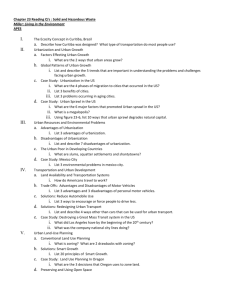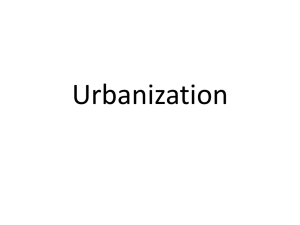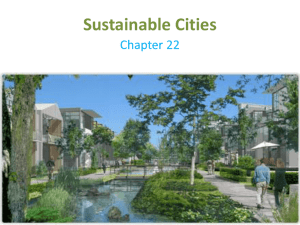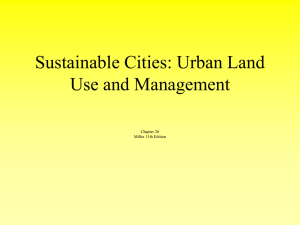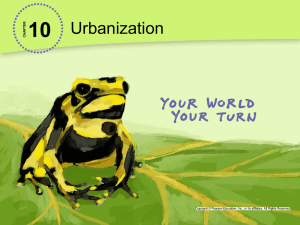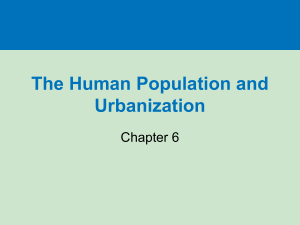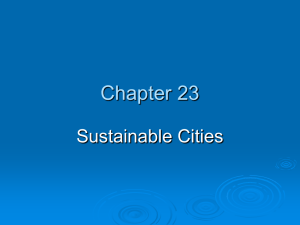Chapter 22 Sustainable Cities
advertisement
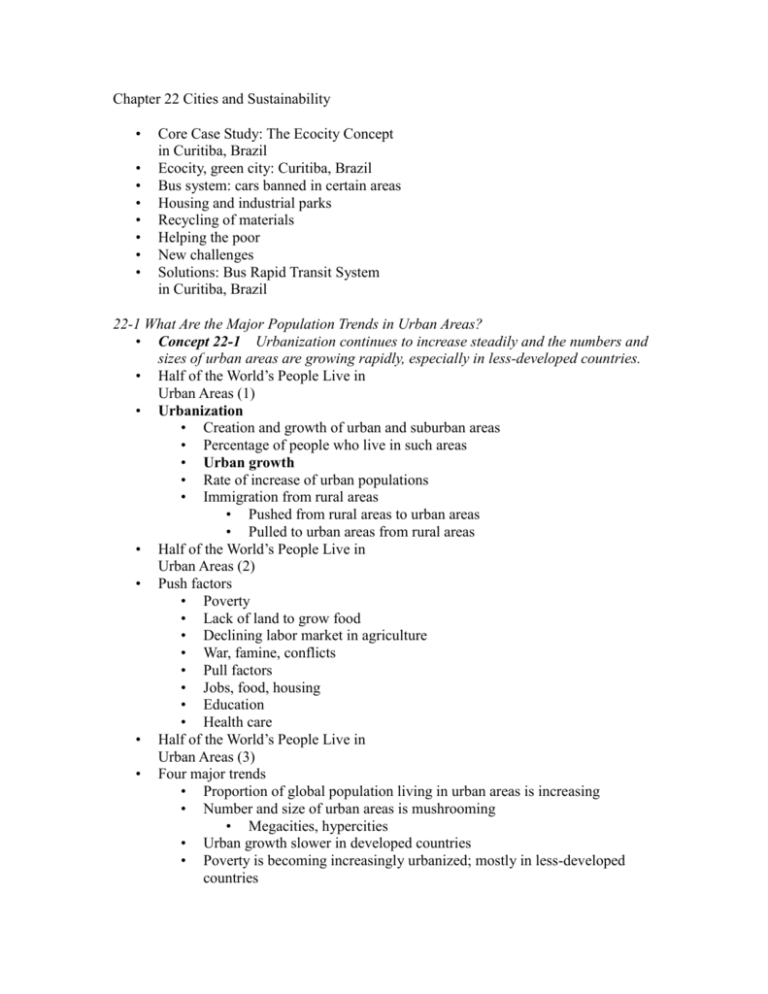
Chapter 22 Cities and Sustainability • • • • • • • • Core Case Study: The Ecocity Concept in Curitiba, Brazil Ecocity, green city: Curitiba, Brazil Bus system: cars banned in certain areas Housing and industrial parks Recycling of materials Helping the poor New challenges Solutions: Bus Rapid Transit System in Curitiba, Brazil 22-1 What Are the Major Population Trends in Urban Areas? • Concept 22-1 Urbanization continues to increase steadily and the numbers and sizes of urban areas are growing rapidly, especially in less-developed countries. • Half of the World’s People Live in Urban Areas (1) • Urbanization • Creation and growth of urban and suburban areas • Percentage of people who live in such areas • Urban growth • Rate of increase of urban populations • Immigration from rural areas • Pushed from rural areas to urban areas • Pulled to urban areas from rural areas • Half of the World’s People Live in Urban Areas (2) • Push factors • Poverty • Lack of land to grow food • Declining labor market in agriculture • War, famine, conflicts • Pull factors • Jobs, food, housing • Education • Health care • Half of the World’s People Live in Urban Areas (3) • Four major trends • Proportion of global population living in urban areas is increasing • Number and size of urban areas is mushrooming • Megacities, hypercities • Urban growth slower in developed countries • Poverty is becoming increasingly urbanized; mostly in less-developed countries • • • • • • • • • • • • • • • • • Urban Shanghai, Suburban Southern California, and Rural Malawi Urban Population Growth Global Outlook: Satellite Image of Major Urban Areas Throughout the World Typical Daily Traffic Jam of People, Carts, and Other Vehicles in Delhi, India Case Study: Urbanization in the United States (1) Four phases between 1800 and 2008 • Migration from rural areas to large central cities • Migration from large central cities to suburbs and smaller cities • Migration from North and East to South and West • Migration from cities and suburbs to developed areas outside the suburbs = exurbs • Urbanization went from 5% to 79% Case Study: Urbanization in the United States (2) Environmental problems decreasing • Better working and housing • Better water and sanitation • Better health care Older cities • Deteriorating services • Aging infrastructures • U.S. $2.2 trillion behind in infrastructure maintenance Major Urban Areas in the United States Revealed by Satellite Images at Night Urban Sprawl Gobbles Up the Countryside (1) Urban sprawl • Low-density development at edges of cities/towns Contributing factors to urban sprawl in the U.S. • Ample land • Low-cost gasoline; highways • Tax laws encouraged home ownership • State and local zoning laws • Multiple political jurisdictions: poor urban planning • Urban Sprawl Gobbles Up the Countryside (2) Megalopolis • Bowash Caused many environmental and economic problems Urban Sprawl in and around the U.S. City of Las Vegas, Nevada, from 1973 to 2000 Natural Capital Degradation: Urban Sprawl 22-2 What Are the Major Urban Resource and Environmental Problems? • Concept 22-2 Most cities are unsustainable because of high levels of resource use, waste, pollution, and poverty. • Urbanization Has Advantages (1) • • • • • • • • • • • • • • • • • • • • Centers of: • Economic development • Innovation • Education • Technological advances • Jobs • Industry, commerce, transportation • Urbanization Has Advantages (2) Urban residents tend to have • Longer lives • Lower infant mortality • Better medical care • Better social services • More recycling programs • Concentrating people in cities can help preserve biodiversity in rural areas Urbanization Has Disadvantages (1) Huge ecological footprints Lack vegetation Water problems Urbanization Has Disadvantages (2) Concentrate pollution and health problems Excessive noise Altered climate and experience light pollution Natural Capital Degradation: Urban Areas Rarely Are Sustainable Systems Noise Levels of Some Common Sounds Life Is a Desperate Struggle for the Urban Poor in Less-Developed Countries Slums Squatter settlements/shantytowns Terrible living conditions • Lack basic water and sanitation • High levels of pollution What can governments do to help? Global Outlook: Extreme Poverty in Rio de Janeiro Slum Case Study: Mexico City Urban area in crisis • Severe air pollution • Water pollution • 50% unemployment • Deafening noise • Overcrowding • Traffic congestion • Inadequate public transportation • 1/3 live in slums (barrios) or squatter settlements • What progress is being made? • Photochemical Smog in Mexico City 22-3 How Does Transportation Affect Urban Environmental Impacts? • Concept 22-3 In some countries, many people live in widely dispersed urban areas and depend mostly on motor vehicles for their transportation, which greatly expands their ecological footprints. • Cities Can Grow Outward or Upward • Compact cities • Hong Kong, China • Tokyo, Japan • Mass transit • Dispersed cities • U.S. and Canada • Car-centered cities • Motor Vehicles Have Advantages and Disadvantages (1) • Advantages • Mobility and convenience • Jobs in • Production and repair of vehicles • Supplying fuel • Building roads • Status symbol • Motor Vehicles Have Advantages and Disadvantages (2) • Disadvantages • Accidents: 1.2 million per year, 15 million injured • Kill 50 million animals per year • Largest source of outdoor air pollution • Helped create urban sprawl • Traffic congestion • Los Angeles Freeways • Reducing Automobile Use Is Not Easy, but It Can Be Done (1) • Full-cost pricing: high gasoline taxes • Educate consumers first • Use funds for mass transit • Opposition from car owners and industry • Lack of good public transit is a problem • Rapid mass transit • Difficult to pass in the United States • Strong public opposition • Dispersed nature of the U.S. • Reducing Automobile Use Is Not Easy, but It Can Be Done (2) • Raise parking fees • Tolls on roads, tunnels, and bridges into major cities • Charge a fee to drive into a major city • Car-sharing • Case Study: Zipcars • Car-sharing network • Rent by the hour • • • • • • • • • • • Saves money for many people • Some Cities Are Promoting Alternatives to Car Ownership Bicycles Heavy-rail systems Light-rail systems Buses Rapid-rail system between urban areas Trade-Offs: Bicycles Trade-Offs: Mass Transit Rail Trade-Offs: Buses Trade-Offs: Rapid Rail Potential Routes for High-Speed Bullet Trains in the U.S. and Parts of Canada 22-4 How Important Is Urban Land-Use Planning? • Concept 22-4 Urban land-use planning can help to reduce uncontrolled sprawl and slow the resulting degradation of air, water, land, biodiversity, and other natural resources. • Conventional Land-Use Planning • Land-use planning • Encourages future population growth • Encourages economic development • Revenues: property taxes • 90% of local government revenue in the U.S. • Environmental and social consequences • Zoning • Problems and potential benefits • Mixed-use zoning • Smart Growth Works (1) • Smart growth • Reduces dependence on cars • Controls and directs sprawl • Cuts wasteful resource • Uses zoning laws to channel growth • Smart Growth Works (2) • Curitiba, Brazil • China: stand on urban sprawl • Europe: compact cities • Solutions: Smart Growth Tools • Case Study: Smart Growth in Portland, Oregon • Since 1975 • Population grew 50% • Urban area expanded 2% • Efficient light-rail and bus system • Abundant green space and parks • Clustered, mixed-use neighborhoods • Air pollution reduced 86% • • • • • Greenest city in the United States • Preserving and Using Open Space Urban growth boundary • U.S. states: Washington, Oregon, and Tennessee Municipal parks • U.S. cities: New York City and San Francisco Greenbelts • Canadian cities: Vancouver and Toronto • Western European cities Central Park, New York City, USA 22-5 How Can Cities Become More Sustainable and Livable? • Concept 22-5 An ecocity allows people to choose walking, biking, or mass transit for most transportation needs; to recycle or reuse most of their wastes; to grow much of their food; and to protect biodiversity by preserving surrounding land. • New Urbanism Is Growing • Conventional housing development • Cluster development • New urbanism, old villageism • Walkability • Mixed-use and diversity • Quality urban design • Environmental sustainability • Smart transportation • Conventional and Cluster Housing Developments • Case Study: New Urban Village of Vauban • Suburb of Freiburg, Germany • Car use heavily discouraged with high parking fees = $40,000 for a parking space • All homes within walking distance of • Trains and other public transit • Stores, banks, restaurants, schools • Much use of renewable energy • The Ecocity Concept: Cities for People Not Cars • Ecocities or green cities • Build and redesign for people • Use renewable energy resources • Recycle and purify water • Use energy and matter resources efficiently • Prevent pollution and reduce waste • Recycle, reuse and compost municipal waste • Protect and support biodiversity • Urban gardens; farmers markets • Zoning and other tools for sustainability • Science Focus: Urban Indoor Farming • Rooftop greenhouses • Sun Works: designs energy-efficient greenhouses • Hydroponic gardens • Skyscraper farms • Ecological advantages and disadvantages • The Ecovillage Movement Is Growing • Ecovillage movement • Eco-hoods • 1993: ecovillage in Los Angeles, CA, U.S. • What is making it work? • Other ecovillages • Success stories • Case Study: A Living Building • Living Building • Designed to fit in with local climate, vegetation, other characteristics • Energy met solely by renewable resources • Capture, treat, reuse all water • Highly energy efficient • Esthetically pleasing • Omega Center for Sustainable Living in Rhinebeck, New York • Three Big Ideas 1. Urbanization is increasing steadily and the numbers and sizes of urban areas are growing rapidly, especially in less-developed countries. 2. Most urban areas are unsustainable with their large and growing ecological footprints and high levels of poverty. 3. Urban areas can be made more sustainable and livable just as some cities and villages already are.
